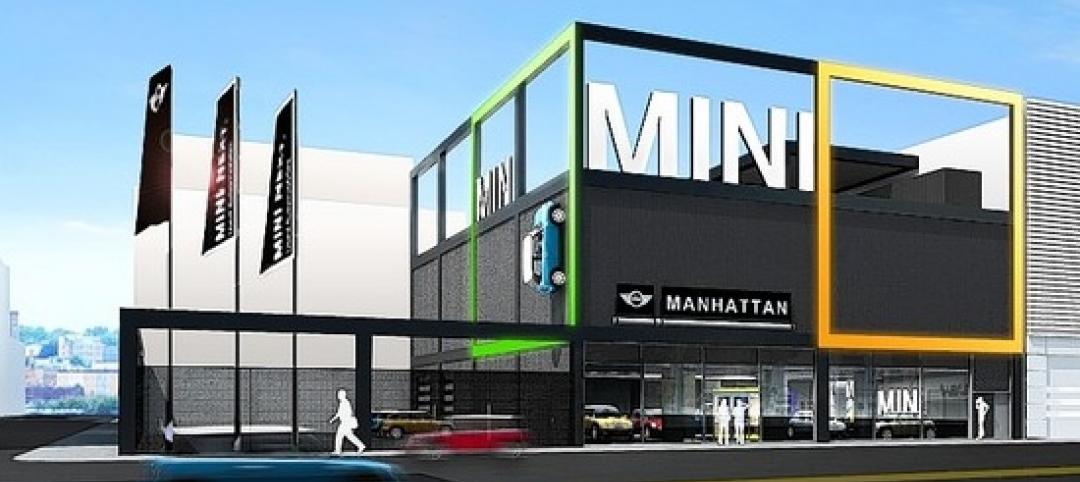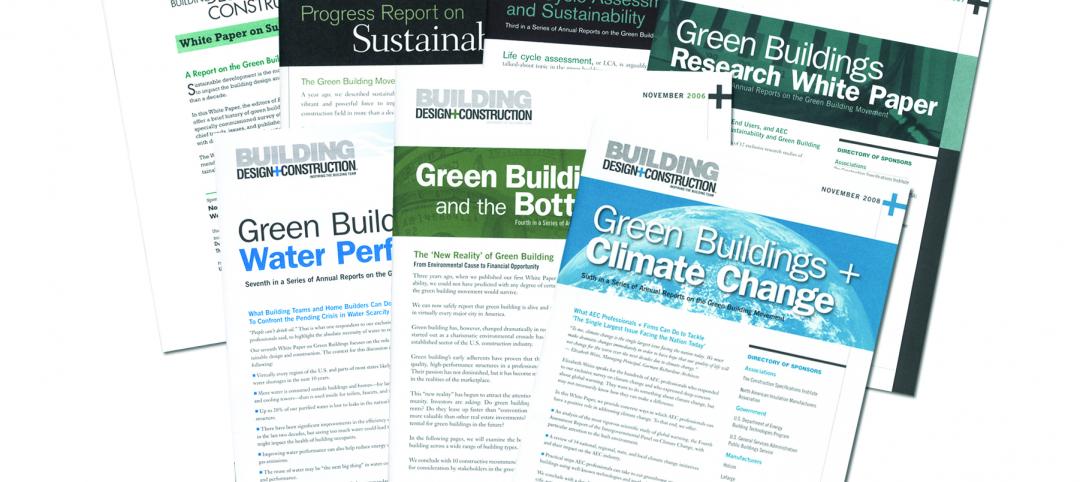 |
|||||||||||||||||||||||||
| The $9.2 billion CityCenter complex in Las Vegas is the nation’s largest privately funded development. Key: A. Mandarin Oriental (Kohn Pedersen Fox Associates); B. Veer (Murphy/Jahn Architects); C. Crystals (Studio Daniel Libeskind); D. The Harmon (Foster + Partners); E. People mover (Gensler); F. Vdara (Rafael Viñoly Architects); G. Aria (Pelli Clarke Pelli); H. Convention Center (Pelli Clarke Pelli); I. Cirque du Soleil theater (Pelli Clarke Pelli). | |||||||||||||||||||||||||
It's early June, in Las Vegas, which means it's very hot, and I am coming to the end of a hardhat tour of the $9.2 billion CityCenter development, a tour that began in the air-conditioned comfort of the project's immense sales center just off the famed Las Vegas Strip and ended on a rooftop overlooking the largest privately funded development in the U.S. and one of the largest construction projects in the world. Only from such a height can you take in the enormity of this 18.6 million-sf mixed-use project. The statistics are staggering: a massive joint venture
It goes without saying that looking at the scale model of the project in the sales office just doesn't do justice to CityCenter. Thus I find myself atop the Bellagio Hotel parking garage, chatting with several architects from the Las Vegas office of San Francisco-based Gensler, the project's master architect. The newly constructed garage borders CityCenter and offers a bird's-eye view into the heart of the project, and it is from this vantage point that I begin to appreciate just how different CityCenter is from anything ever built in Las Vegas.
Apparently my response to the project is not unique. “People don't really understand it or feel it until they walk through it,” says Sven Van Assche, VP of MGM Design Group. “It's experiential, the progression of taking yourself through the project, going from neighborhood to neighborhood, from experience to experience,” he says. “We are doing something so different from what we've done before, something outside our own box.” Van Assche acknowledges how a project of this scale could easily become intimidating and overwhelming, emotions at odds with MGM Mirage's core business of providing hospitality. He worked with New York-based Ehrenkrantz Eckstut and Kuhn Architects to create a master plan that broke down the project's scale into three neighborhoods with the unpoetic titles Blocks A, B, and C. The goal, according to Van Assche: “to make being in CityCenter a more inviting, comfortable, and welcoming experience for the customer.” The concept of neighborhood reinforces CityCenter's urban aspirations. Van Assche, sounding very much like a disciple of Jane Jacobs, says that a walk around a city like New York produces multiple experiences that come from encountering diverse building types—stores, restaurants, hotels, housing, entertainment venues—with surprises around every corner. “What makes great cities so much fun is their diversity and energy,” says Van Assche. “We're trying to create that energy.” Creating a real-city vibe through a diverse product mix led Van Assche to seek out world-class architects who hadn't previously worked in Las Vegas, each of whom could all add something new and exciting to the mix. Van Assche says he sought designers with global reputations and the ability to work as a cohesive team. “It was about finding the most creative architects who could fit the vision we were trying to achieve,” he says. “They've been successful in doing enormously creative work around the world, and they've done so in an architectural vernacular we were interested in ourselves,” says Van Assche. Before anyone signed on, however, Van Assche made sure they checked their egos at the airport. “They had to be interested in being part of a project where it wasn't all about them,” he says. “They needed to understand how intimately we were going to integrate these buildings with one another, and that they would have to collaborate with people who are normally their competitors.” The bottom line: “The synergy had to be positive.” A two-month-long design review helped sort out the assignments: Pelli Clark Pelli was awarded the Aria hotel, casino, convention center, and Cirque du Soleil theatre; Rafael Viñoly Architects, the Vdara condo hotel; Kohn Pedersen Fox Associates, the Mandarin Oriental; Murphy/Jahn, the Veer condominium towers; Foster + Partners, The Harmon hotel and residential tower; and Studio Daniel Libeskind, Crystals retail complex. Each firm was granted significant autonomy over their respective projects as long as they worked within the contemporary aesthetic that MGM Mirage wanted. “The architects all created buildings that are very unique unto themselves, but they did it all using the same ingredients,” says Van Assche. |
Related Stories
| Apr 19, 2011
BMW dealers driving up sustainable construction in NYC
BMW North America will invest $60 million in two green dealerships in Manhattan. The new stores, which are being designed to cut energy use by 25%, reflect the auto company’s effort to reposition itself as environmentally conscious.
| Apr 19, 2011
15 mind-blowing skyscrapers
Our friends at Inhabitat have rounded up 15 incredible buildings—from underground cities to vertical farms to bio-fuel power plants and skyscrapers.
| Apr 19, 2011
Help the editors choose the next BD+C White Paper topic
The editors of Building Design+Construction want your input on the topic (or topics) we should tackle for our 2012 green building White Paper. Send us your ideas today.
| Apr 14, 2011
U.S. embassies on a mission to green the world's buildings
The U.S. is putting greater emphasis on greening its worldwide portfolio of embassies. The U.S. State Department-affiliated League of Green Embassies already has 70 U.S. embassies undergoing efforts to reduce their environmental impact, and the organization plans to increase that number to more than 100 by the end of the year.
| Apr 14, 2011
USGBC debuts LEED for Healthcare
The U.S. Green Building Council (USGBC) introduces its latest green building rating system, LEED for Healthcare. The rating system guides the design and construction of both new buildings and major renovations of existing buildings, and can be applied to inpatient, outpatient and licensed long-term care facilities, medical offices, assisted living facilities and medical education and research centers.
| Apr 13, 2011
Danfoss Chairman of the Board Joins Clinton Global Initiative
Danfoss, a leading manufacturer of high-efficiency electronic and mechanical components and controls for air-conditioning, heating, refrigeration and motion systems, today announced that Jorgen M. Clausen, Chairman of the Board, has received and accepted a membership from former President Bill Clinton to join the Clinton Global Initiative.
| Apr 13, 2011
Southern Illinois park pavilion earns LEED Platinum
Erin’s Pavilion, a welcome and visitors center at the 80-acre Edwin Watts Southwind Park in Springfield, Ill., earned LEED Platinum. The new 16,000-sf facility, a joint project between local firm Walton and Associates Architects and the sustainability consulting firm Vertegy, based in St. Louis, serves as a community center and special needs education center, and is named for Erin Elzea, who struggled with disabilities during her life.
| Apr 13, 2011
Virginia hospital’s prescription for green construction: LEED Gold
Rockingham Memorial Hospital in Harrisonburg, Va., is the commonwealth’s first inpatient healthcare facility to earn LEED Gold. The 630,000-sf facility was designed by Earl Swensson Associates, with commissioning consultant SSRCx, both of Nashville.
| Apr 13, 2011
Duke University parking garage driven to LEED certification
People parking their cars inside the new Research Drive garage at Duke University are making history—they’re utilizing the country’s first freestanding LEED-certified parking structure.
| Apr 12, 2011
American Institute of Architects announces Guide for Sustainable Projects
AIA Guide for Sustainable Projects to provide design and construction industries with roadmap for working on sustainable projects.
















